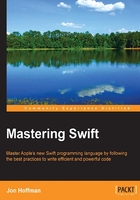
Foundation data types
When using foundation data types, Swift provides an overlay that makes interacting with them feel like they are native Swift types. We use this overlay to interact with foundation types, such as CGSize and CGRect for iOS applications (NSSize and NSRect for OS X applications). When developing iOS or OS X applications, we will interact with foundation types on a regular basis, so it is good to see this overlay in action.
Let's look at how to initialize some foundation data types. The following example defines NSRange, CGRect, and NSSize:
var range = NSRange(location: 3, length: 5) var rect = CGRect(x: 10, y: 10, width: 20, height: 20) var size = NSSize(width: 20, height: 40)
The overlay also lets us access the properties and functions in a way that feels like native Swift types. The following example shows us how to access the properties and functions:
var rect = CGRect(x: 10, y: 10, width: 20, height: 20) rect.origin.x = 20 //Changes the X value from 10 to 20 var rectMaxY = rect.maxY //rectMaxY contains 30 (value of y + value of height) var validRect = rect.isEmpty //validRect contains false because rect is valid.
In the preceding code, we initialize a CGRect type. We then change the property of x from 10 to 20, retrieve the value of the maxY property, and check the isEmpty property to see whether we have a valid CGRect type.
We just barely scratched the surface of the interoperability between Swift and Objective-C. We will discuss this interoperability in depth in Chapter 11, Using Mix and Match later in this book.